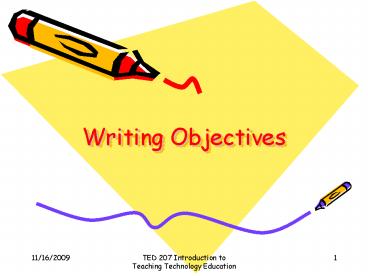Writing Objectives - PowerPoint PPT Presentation
1 / 29
Title:
Writing Objectives
Description:
Extremely broad statements that are used to describe the ... Nomenclature (often used interchangeably within column) Educational goals. Educational aims ... – PowerPoint PPT presentation
Number of Views:26
Avg rating:3.0/5.0
Title: Writing Objectives
1
Writing Objectives
2
Learning
- Change in a students capacity for performance as
a result of experience.
3
Goals
- Extremely broad statements that are used to
describe the purposes of schooling, a course, or
a unit of instruction. - Goals are written with covert (broad,
nonobservable) verbs.
4
Objectives
- Clear and unambiguous descriptions of
instructional intent. - Objectives are written with overt (observable
therefore measurable) verbs.
5
Objectives (2)
- Narrower statements of the intended learning of a
unit or specific lesson. - Each statement (objective) focuses on one
behavior expressed in the verb.
6
Why Objectives?
- Teaching approach will be dictated by objectives.
- Set the framework for evaluation.
- Assist in communication with students Students
should always know what is expected of them. - They are required!
7
Specificity
- Educational Goal
- Informational Objective
- Instructional Objective
8
Nomenclature (often used interchangeably within
column)
- Educational goals
- Educational aims
- General objectives
- Specific objectives
- Informational objectives
- Behavioral objectives
- Performance objectives
- Instructional objectives
9
Behavior
- Covert
- Not easily observed
- Internal changes
- Less clearly measurable
10
Behavior
- Overt
- Observable
- Can be tested and measured
11
Components
- Well stated objectives should include
- Found in Commonly used
- the Text but not in Text Audience
- The performance
- A product Behavior
- The conditions Condition
- The criterion (degree) Criterion
12
Behavior
- Behavior is made up of the performance and the
product.
13
Performance
- What students are expected to do
- Use an indicator or behavior verb to specify
action - Indicate exactly what student actions are to be
observed as a result of instruction
14
Product
- What students will produce by their action
- The product is evaluated to determine whether the
objective has been mastered - Planned outcome resulting from the instructional
process
15
Criterion
- Level of acceptable student performance
- Level of behavior accepted as satisfactory for
showing mastery
16
Informational and Instructional Objectives
- Informational Objective
- An abbreviation of the instructional objective
omits the conditions and criterion - Instructional Objective
- Contain all four components of a well-stated
objective
17
Blooms Taxonomy
- 3 Domains
- Cognitive (Too often our main focus)
- Affective
- Psychomotor
18
Blooms RevisedTaxonomy
- Cognitive Domain
Creating
Evaluating
Analyzing
Applying
Thinking begins here!
Understanding
Remembering
19
Blooms Taxonomy
- Affective Domain
Commitment
Valuing
Responding
Receiving
20
Blooms Taxonomy
- Psychomotor Domain
Precision
Manipulation
Imitation
21
References
Department of Middle/Secondary Education
Instructional Technology. (1999). Mager's tips
on instructional objectives. Atlanta, GA
Georgia State University. On-line at
http//www2.gsu.edu/mstmbs/CrsTools/Magerobj.htm
lObj ectives20Defined Mamlin, N. (n.d.) The
dreaded behavioral objective! Boone, NC
Appalachian State University. On-line at
http//pm.appstate.edu/mamlinnl/behavior.htm
VanFossen, P. (1999). Overview of instructional
objectives. Lafayette, IN Purdue University.
On-line at http//www.edci.purdue.edu/vanfossen/I
nstructionalObjective s.html
22
Selecting Instruction
- Categories of Learning
Thinking Skills
Concepts and Principles
Facts
23
Teaching Concepts
- Concept a category to which a set of objects,
conditions, events, or processes can be grouped
based on some similarities they have in common. - Look at the following example of a concept.
24
Universal Systems Model
Production Management Action
End Results
People Capital Knowledge Materials Energy Time
Finance
Did it work? How well did it work?
25
Concept Learning
- Observation and association
- Definition and verbal explanation
- Diagrams, mappings, and webbings
- Scaffolding support to the student
26
Teaching Thinking Skills
- Critical Thinking generally requires higher
levels of thinking (i.e. evaluation and
synthesis) - Creative Thinking putting together information
to come up with a new understanding, concept, or
idea.
27
Stages of Creative Thinking
Verification
Illumination
Incubation
Creative thinkers climb the ladder.
Preparation
28
Learning Communities
- The goal is to provide a richer range of learning
experiences to students and to contribute a more
vibrant and supportive environment for students
and teachers alike. - It Takes a Village. Sen. Hillary Clinton
29
Service Learning
- Initiated from the State, District, or school.
- The goal of service learning is for students to
become less self-centered and more motivated to
help others. - Promotes political and moral development
- Help foster civic responsibility
- Improve academic grades
- Increase school attendance































